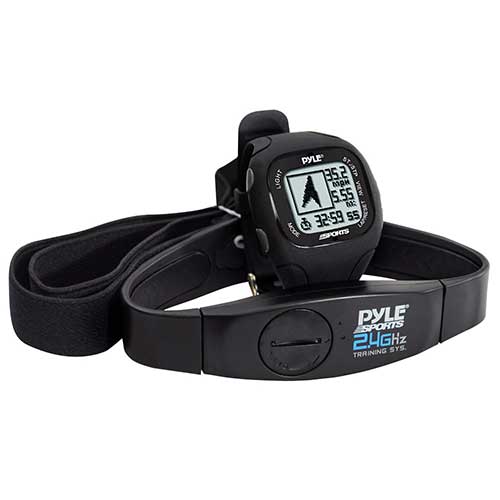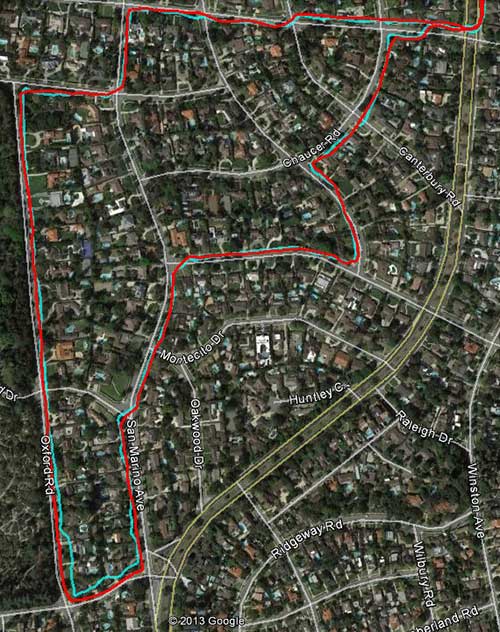I went out for a hike today, with Strava and RunKeeper simultaneously running on my iPhone 4S, and the Pyle PSWGP405BK on my wrist. Unfortunately, my wife had the Garmin Forerunner 10, so I have to use an old track, recorded last week, at approximately the same time of day. I know that it’s not an ideal comparison, but it will have to suffice for this article. The route was in mountainous terrain, through a canyon … a much more challenging for a GPS than the flat route that I used in my last comparison. Here’s RunKeeper’s take on the track: 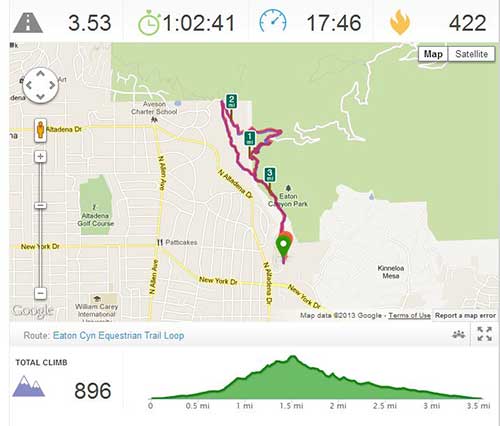 Strava’s take, running simultaneously on the iPhone with RunKeeper:
Strava’s take, running simultaneously on the iPhone with RunKeeper:  Strava’s exported GPX file, imported to RunKeeper.com:
Strava’s exported GPX file, imported to RunKeeper.com:  What’s revealing is that given the same data, RunKeeper.com and Strava calculate essentially identical distances. This becomes important when we compare them to the Pyle. Strangely, RunKeeper.com shows a 13 second shorter duration, but identical average pace. The data downloaded from the Pyle and displayed in GPS Master are identical to what displayed on the watch:
What’s revealing is that given the same data, RunKeeper.com and Strava calculate essentially identical distances. This becomes important when we compare them to the Pyle. Strangely, RunKeeper.com shows a 13 second shorter duration, but identical average pace. The data downloaded from the Pyle and displayed in GPS Master are identical to what displayed on the watch: 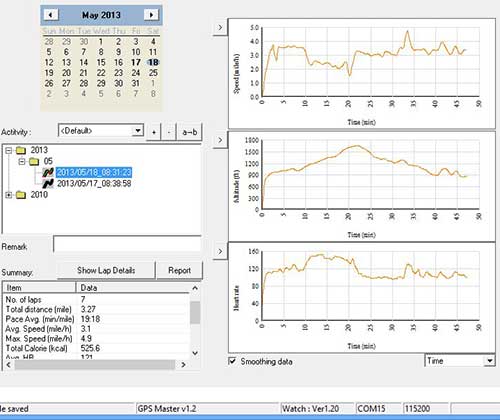 I used the Pyle’s included wireless heart rate monitor on this hike, and its connectivity was flawless during the entire recording. I didn’t have to moisten the contacts in order to get a good reading, which was also nice. GPS Master shows my average heart rate was 121, and the max was 155. The plots above are speed, altitude, and heart rate. The GPX file exported from GPS Master and uploaded to RunKeeper.com:
I used the Pyle’s included wireless heart rate monitor on this hike, and its connectivity was flawless during the entire recording. I didn’t have to moisten the contacts in order to get a good reading, which was also nice. GPS Master shows my average heart rate was 121, and the max was 155. The plots above are speed, altitude, and heart rate. The GPX file exported from GPS Master and uploaded to RunKeeper.com: 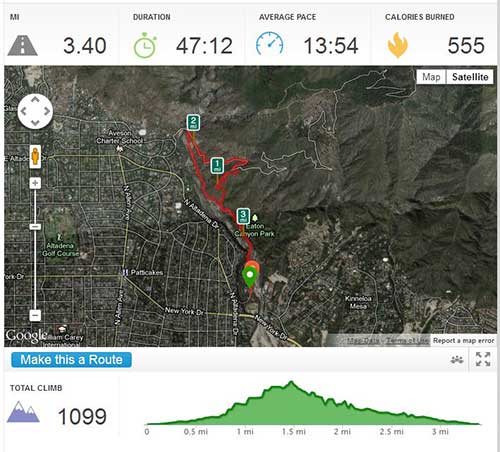 A comparison table gleaned from the above data:
A comparison table gleaned from the above data:
| Distance (mi) | Calories | |
| Strava | 3.7 | N/A |
| Strava track on RunKeeper.com | 3.71 | 600 |
| RunKeeper | 3.53 | 422 |
| Pyle PSWGP405BK | 3.27 | 526 |
| Pyle PSWGP405BK track on RunKeeper.com | 3.40 | 555 |
Once again, the Pyle PSWGP405BK and GPS Master displayed identical data, and the calculated distance was shorter than RunKeeper’s calculation using the Pyle’s exported GPX data. I am convinced that the Pyle’s distance calculation is too conservative… 3.27mi vs 3.40mi calculated by RunKeeper.com on the same data. Strava calculated 3.7 mi, which is too long, due to its poor filtering of the iPhone’s noisy data stream. The Google Earth plots below will reveal more information. Here is a Google Earth plot of Strava (green), RunKeeper (red), Pyle (blue), and Garmin FR10 (yellow) in the most challenging part of the track:  Strava (green) vs RunKeeper (red)
Strava (green) vs RunKeeper (red) 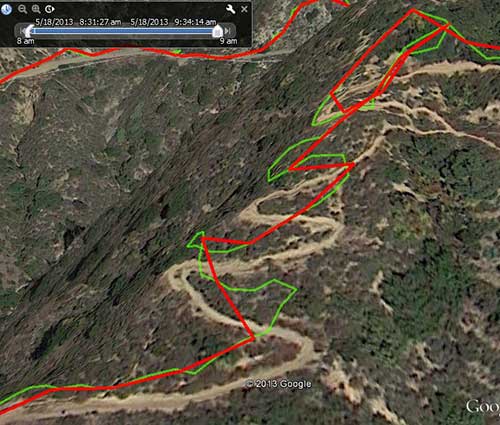 Viewing the track reveals why Strava calculated the longest distance. Strava’s filtering algorithm is clearly inferior to RunKeeper’s in handling the iPhone’s poor quality location data stream. Pyle (blue) vs Garmin (yellow)
Viewing the track reveals why Strava calculated the longest distance. Strava’s filtering algorithm is clearly inferior to RunKeeper’s in handling the iPhone’s poor quality location data stream. Pyle (blue) vs Garmin (yellow)  Again, not an entirely valid comparison, since the Garmin track was recorded on a different outing, but it’s quite obvious that the Garmin outperforms the Pyle in accuracy. The Garmin is the only device that was able to trace all of the switchbacks on the trail. Even in the less challenging parts of the track, the Pyle wanders a bit. Still, the Pyle’s accuracy far exceeds that of the apps running on the iPhone. I am very disappointed that several reviewers said that the Pyle is very accurate. Clearly, they didn’t do their homework. The Pyle PSWGP405BK consistently calculates distances too short. The Forerunner 10 kicks Pyle’s ass. But the Pyle has a compass, navigation, and heart rate monitor for about the same price, and is not that bad, as long as you don’t mind the fact that it miscalculates distance, and have to use other software in order to extract the correct distances from its track. If you want to play with my data, you can download the tracks an view them in Google Earth yourself: eckml.zip Strava doesn’t export KML, but Google Earth can easily import its KML file. I have also included full size image files of the screen shots I showed above. In case you decide to compare the gory details of the tracks, when I got to the top of the winding trail above, I took a little break to fix my socks in a tree-covered area. The FR10 track doesn’t show me deviating from the trail, because I didn’t take the detour during that outing.
Again, not an entirely valid comparison, since the Garmin track was recorded on a different outing, but it’s quite obvious that the Garmin outperforms the Pyle in accuracy. The Garmin is the only device that was able to trace all of the switchbacks on the trail. Even in the less challenging parts of the track, the Pyle wanders a bit. Still, the Pyle’s accuracy far exceeds that of the apps running on the iPhone. I am very disappointed that several reviewers said that the Pyle is very accurate. Clearly, they didn’t do their homework. The Pyle PSWGP405BK consistently calculates distances too short. The Forerunner 10 kicks Pyle’s ass. But the Pyle has a compass, navigation, and heart rate monitor for about the same price, and is not that bad, as long as you don’t mind the fact that it miscalculates distance, and have to use other software in order to extract the correct distances from its track. If you want to play with my data, you can download the tracks an view them in Google Earth yourself: eckml.zip Strava doesn’t export KML, but Google Earth can easily import its KML file. I have also included full size image files of the screen shots I showed above. In case you decide to compare the gory details of the tracks, when I got to the top of the winding trail above, I took a little break to fix my socks in a tree-covered area. The FR10 track doesn’t show me deviating from the trail, because I didn’t take the detour during that outing.
Previous Related Post: Garmin Forerunner 10 vs Pyle PSWGP405BK
Next Related Post: Accuracy of Pyle PSWGP405BK vs RunKeeper Revisited
